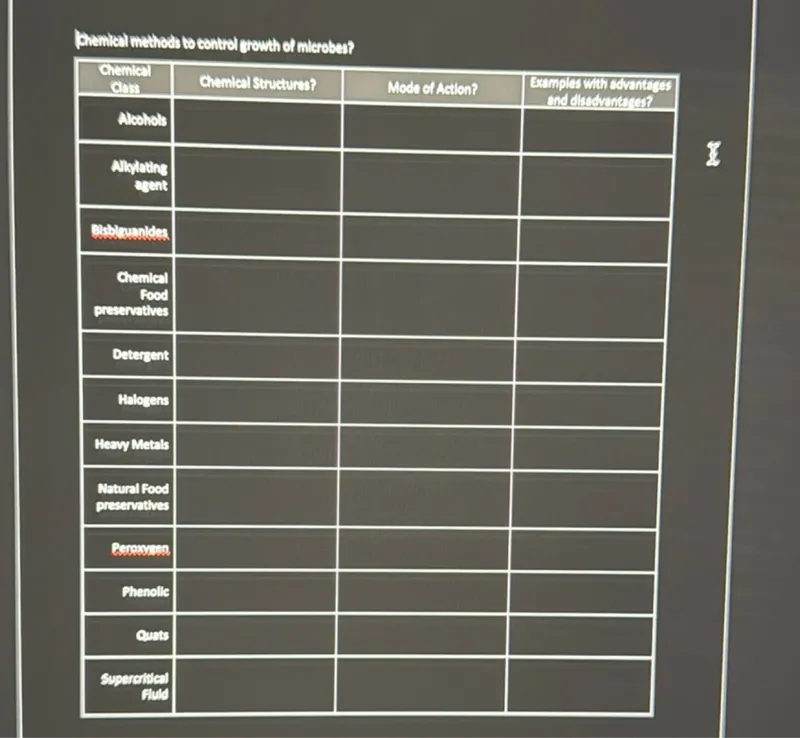I'll complete the table with information about different chemical germicides, their structures, modes of action, and examples with advantages and disadvantages.
Complete the table with information about different classes of chemical germicides
Alcohols
Chemical Structure: R-OH (where R is an alkyl group)
Mode of Action: Denature proteins and disrupt cell membranes by dissolving lipids
Examples with advantages and disadvantages:
- Ethanol (70-95%): Quick acting, leaves no residue
- Isopropanol (70-90%): Less volatile than ethanol
Advantages: Non-staining, inexpensive, rapid action
Disadvantages: Volatile, flammable, not effective against spores, inactive when dry
Alkylating agents
Chemical Structure: Contain reactive groups (e.g., epoxides, aldehydes) that can transfer alkyl groups
Mode of Action: Alkylate nucleic acids and proteins, preventing cell replication and protein synthesis
Examples with advantages and disadvantages:
- Formaldehyde: Broad spectrum, effective against spores
- Glutaraldehyde: Used for sterilizing medical equipment
Advantages: Highly effective, broad spectrum activity
Disadvantages: Toxic, irritating to skin and mucous membranes, carcinogenic potential
Biguanides
Chemical Structure: Compounds with -NH-C(=NH)-NH-C(=NH)-NH- functional groups
Mode of Action: Disrupt cell membranes, precipitate cellular proteins
Examples with advantages and disadvantages:
- Chlorhexidine: Common antiseptic in healthcare
Advantages: Persistent activity, low toxicity, effective against many microbes
Disadvantages: Ototoxicity risk, potential allergic reactions, less effective against some gram-negative bacteria
Chemical Food preservatives
Chemical Structure: Various (benzoates, sorbates, nitrites, etc.)
Mode of Action: Inhibit microbial enzymes, alter pH, or disrupt cell membranes
Examples with advantages and disadvantages:
- Sodium benzoate: Effective in acidic foods
- Potassium sorbate: Inhibits molds and yeasts
Advantages: Extend shelf life, prevent spoilage, cost-effective
Disadvantages: Some health concerns, potential allergic reactions, regulatory limitations
Detergents
Chemical Structure: Amphipathic molecules with hydrophilic and hydrophobic regions
Mode of Action: Disrupt cell membranes by emulsifying lipids
Examples with advantages and disadvantages:
- Quaternary ammonium compounds (QACs): Used in disinfectants
- Benzalkonium chloride: Common in sanitizers
Advantages: Stable, non-corrosive, effective against many bacteria
Disadvantages: Limited activity against spores and some viruses, inactivated by organic matter
Halogens
Chemical Structure: Compounds containing F, Cl, Br, I (especially Cl and I in germicides)
Mode of Action: Oxidize cellular components, halogenate proteins
Examples with advantages and disadvantages:
- Chlorine (as hypochlorite): Used in water treatment
- Iodine (as povidone-iodine): Surgical antiseptic
Advantages: Broad spectrum, rapid action, relatively inexpensive
Disadvantages: Corrosive, irritating, can be inactivated by organic matter
Heavy Metals
Chemical Structure: Compounds containing mercury, silver, copper, etc.
Mode of Action: Bind to protein sulfhydryl groups, denature proteins
Examples with advantages and disadvantages:
- Silver nitrate: Used in wound care
- Copper sulfate: Algicide in water treatment
Advantages: Long-lasting activity, effective at low concentrations
Disadvantages: Environmental concerns, potential toxicity, resistance development
Natural Food preservatives
Chemical Structure: Various (essential oils, organic acids, etc.)
Mode of Action: Multiple mechanisms including membrane disruption, enzyme inhibition
Examples with advantages and disadvantages:
- Essential oils (thymol, carvacrol): From herbs like thyme and oregano
- Nisin: Antimicrobial peptide from bacteria
Advantages: Consumer-friendly, "clean label," often dual functionality (flavor and preservation)
Disadvantages: Variable efficacy, potential flavor impact, higher cost
Quaternary Ammonium Compounds
Chemical Structure: N⁺R₄X⁻ where R is alkyl groups and X is halide
Mode of Action: Disrupt cell membranes, denature proteins
Examples with advantages and disadvantages:
- Benzalkonium chloride: Common in sanitizers and disinfectants
- Cetrimide: Used in antiseptic solutions
Advantages: Stable, non-corrosive, effective against many bacteria and enveloped viruses
Disadvantages: Limited activity against non-enveloped viruses and spores, inactivated by hard water
Phenolics
Chemical Structure: Aromatic compounds with hydroxyl groups attached to aromatic rings
Mode of Action: Disrupt cell membranes, denature proteins
Examples with advantages and disadvantages:
- Phenol: Original antiseptic used by Lister
- Triclosan: Used in consumer products
Advantages: Effective in presence of organic matter, residual activity
Disadvantages: Environmental concerns, potential toxicity, strong odor
Oxidants
Chemical Structure: Compounds that readily donate oxygen or remove electrons
Mode of Action: Oxidize cellular components, disrupt cell membranes
Examples with advantages and disadvantages:
- Hydrogen peroxide: Common antiseptic
- Peracetic acid: High-level disinfectant
Advantages: Broad spectrum, environmentally friendly breakdown products
Disadvantages: Corrosive, can be unstable, potential material compatibility issues
Supercritical Fluids
Chemical Structure: Substances at temperature and pressure above critical point (often CO₂)
Mode of Action: Penetrate cells causing rapid depressurization damage, extract vital components
Examples with advantages and disadvantages:
- Supercritical CO₂: Used in food processing
Advantages: Non-toxic, leaves no residue, effective at low temperatures
Disadvantages: Requires specialized equipment, high initial cost, limited efficacy against some microbes
\boxed{\text{Completed table of chemical germicides with their structures, modes of action, and examples}}
\boxed{\text{Comprehensive table of chemical germicides including alcohols, alkylating agents, biguanides, food preservatives, detergents, halogens, heavy metals, natural preservatives, quaternary ammonium compounds, phenolics, oxidants, and supercritical fluids with their chemical structures, modes of action, and examples with advantages and disadvantages.}}






